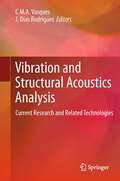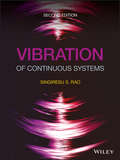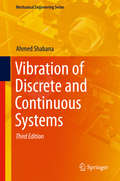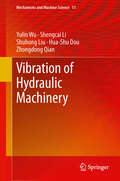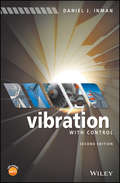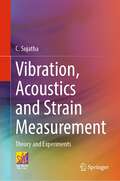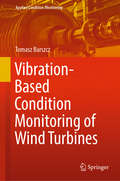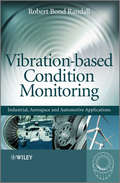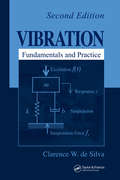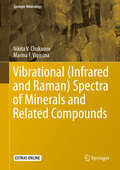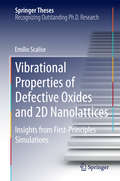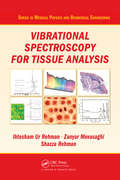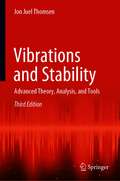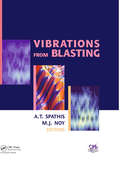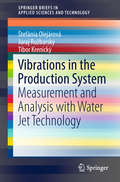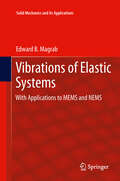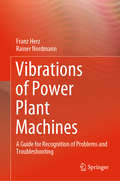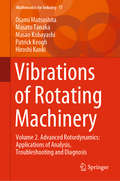- Table View
- List View
Vibration and Oscillation of Hydraulic Machinery (Hydraulic Machinery Series)
by Hideo OhashiThis volume is concerned with vibration-free and quiet operation of hydraulic machines. It deals with the problems caused by mechanical and hydraulic excitations in hydraulic machinery (except for transients which are treated in a separate volume). The invited authors from five continents are internationally recognized experts in their fields. The book looks at the fundamentals for analysis of fluid structure systems, structural vibration, shaft rotordynamics and system instability; noise and diagnosis are introduced with examples from practical experience.
Vibration and Structural Acoustics Analysis
by J. Dias Rodrigues C.M.A. VasquesVibration and structural acoustics analysis has become an essential requirement for high-quality structural and mechanical design in order to assure acoustic comfort and the integrity, reliability and fail-safe behavior of structures and machines. The underlying technologies of this field of multidisciplinary research are evolving very fast and their dissemination is usually scattered over different and complementary scientific and technical publication means. In order to make it easy for developers and technology end-users to follow the latest developments and news in the field, this book collects into a single volume selected, extended, updated and revised versions of papers presented at the Symposium on Vibration and Structural Acoustics Analysis, coordinated by J. Dias Rodrigues and C. M. A. Vasques, which was organised as part of the 3rd International Conference on Integrity, Reliability & Failure (IRF'2009), co-chaired by J. F. Silva Gomes and Shaker A. Meguid, held at the Faculty of Engineering of the University of Porto, Portugal, 20-24 July 2009. These papers where chosen from the more than 60 papers presented at the conference symposium. Written by experienced practitioners and researchers in the field, this book brings together recent developments in the field, spanning across a broad range of themes: vibration analysis, analytical and computational structural acoustics and vibration, material systems and technologies for noise and vibration control, vibration-based structural health monitoring/evaluation, machinery noise/vibration and diagnostics, experimental testing in vibration and structural acoustics, applications and case studies in structural acoustics and vibration. Each chapter presents and describes the state of the art, presents current research results and discusses the need for future developments in a particular aspect of vibration and structural acoustics analysis. The book is envisaged to be an appealing text for newcomers to the subject and a useful research study tool for advanced students and faculty members. Practitioners and researchers may also find this book a one-stop reference that addresses current and future challenges in this field. The variety of case studies is expected to stimulate a holistic view of sound and vibration and related fields and to appeal to a broad spectrum of engineers such as the ones in the mechanical, aeronautical, aerospace, civil and electrical communities.
Vibration in Continuous Media
by Jean-Louis GuyaderThree aspects are developed in this book: modeling, a description of the phenomena and computation methods. A particular effort has been made to provide a clear understanding of the limits associated with each modeling approach. Examples of applications are used throughout the book to provide a better understanding of the material presented.
Vibration of Continuous Systems
by Singiresu S. RaoA revised and up-to-date guide to advanced vibration analysis written by a noted expert The revised and updated second edition of Vibration of Continuous Systems offers a guide to all aspects of vibration of continuous systems including: derivation of equations of motion, exact and approximate solutions and computational aspects. The author—a noted expert in the field—reviews all possible types of continuous structural members and systems including strings, shafts, beams, membranes, plates, shells, three-dimensional bodies, and composite structural members. Designed to be a useful aid in the understanding of the vibration of continuous systems, the book contains exact analytical solutions, approximate analytical solutions, and numerical solutions. All the methods are presented in clear and simple terms and the second edition offers a more detailed explanation of the fundamentals and basic concepts. Vibration of Continuous Systems revised second edition: • Contains new chapters on Vibration of three-dimensional solid bodies; Vibration of composite structures; and Numerical solution using the finite element method • Reviews the fundamental concepts in clear and concise language • Includes newly formatted content that is streamlined for effectiveness • Offers many new illustrative examples and problems • Presents answers to selected problems Written for professors, students of mechanics of vibration courses, and researchers, the revised second edition of Vibration of Continuous Systems offers an authoritative guide filled with illustrative examples of the theory, computational details, and applications of vibration of continuous systems.
Vibration of Discrete and Continuous Systems (Mechanical Engineering Series)
by Ahmed ShabanaThis revised, updated textbook adds new focus on computational methods and the importance of vibration theory in computer-aided engineering to fundamental aspects of vibration of discrete and continuous systems covered in the previous two editions of Vibration of Discrete and Continuous Systems. Building on the book’s emphasis on the theory of vibration of mechanical, structural, and aerospace systems, the author’s modifications, including discussion of the sub-structuring and finite element formulations, complete the coverage of topics required for a contemporary, second course following Vibration Theory. The textbook is appropriate for both upper-level undergraduate and graduate courses.
Vibration of Hydraulic Machinery
by Hua-Shu Dou Shengcai Li Shuhong Liu Yulin Wu Zhongdong QianVibration of Hydraulic Machinery deals with the vibration problem which has significant influence on the safety and reliable operation of hydraulic machinery. It provides new achievements and the latest developments in these areas, even in the basic areas of this subject. The present book covers the fundamentals of mechanical vibration and rotordynamics as well as their main numerical models and analysis methods for the vibration prediction. The mechanical and hydraulic excitations to the vibration are analyzed, and the pressure fluctuations induced by the unsteady turbulent flow is predicted in order to obtain the unsteady loads. This book also discusses the loads, constraint conditions and the elastic and damping characters of the mechanical system, the structure dynamic analysis, the rotor dynamic analysis and the system instability of hydraulic machines, including the illustration of monitoring system for the instability and the vibration in hydraulic units. All the problems are necessary for vibration prediction of hydraulic machinery.
Vibration of Plates
by Snehashish ChakravertyPlates are integral parts of most engineering structures and their vibration analysis is required for safe design. Vibration of Plates provides a comprehensive, self-contained introduction to vibration theory and analysis of two-dimensional plates. Reflecting the author's more than 15 years of original research on plate vibration, this book present
Vibration with Control
by Daniel J. InmanAn advanced look at vibration analysis with a focus on active vibration suppression As modern devices, from cell phones to airplanes, become lighter and more flexible, vibration suppression and analysis becomes more critical. Vibration with Control, 2nd Edition includes modelling, analysis and testing methods. New topics include metastructures and the use of piezoelectric materials, and numerical methods are also discussed. All material is placed on a firm mathematical footing by introducing concepts from linear algebra (matrix theory) and applied functional analysis when required. Key features: Combines vibration modelling and analysis with active control to provide concepts for effective vibration suppression. Introduces the use of piezoelectric materials for vibration sensing and suppression. Provides a unique blend of practical and theoretical developments. Examines nonlinear as well as linear vibration analysis. Provides Matlab instructions for solving problems. Contains examples and problems. PowerPoint Presentation materials and digital solutions manual available for instructors. Vibration with Control, 2nd Edition is an ideal reference and textbook for graduate students in mechanical, aerospace and structural engineering, as well as researchers and practitioners in the field.
Vibration, Acoustics and Strain Measurement: Theory and Experiments
by C. SujathaThis textbook provides a comprehensive description of a variety of vibration and acoustic pickups and exciters, as well as strain gauge transducers. It is an exhaustive manual for setting up basic and involved experiments in the areas of vibration, acoustics and strain measurement (using strain gauges only). It further serves as a reference to conduct experiments of a pedagogical nature in these areas. It covers the various theoretical aspects of experimental test rigs, as well as a description and choice of transducers/equipment. The fundamentals of signal processing theory, including the basics of random signals, have been included to enable the user to make a proper choice of settings on an analyser or measuring equipment. Also added is a description of modal analysis theory and related parameter extraction techniques. All chapters are provided with conceptual questions which will provoke the reader to think and gain a better understanding of the subjects. The textbook illustrates around fifty experiments in the areas of vibration, acoustics and strain measurements. Given the contents, this textbook is useful for undergraduate and postgraduate students in the areas of mechanical engineering, with applications that range from civil structures, architectural and environmental systems, and all forms of mechanical systems including transport vehicles and aircraft.
Vibration-Based Condition Monitoring of Wind Turbines (Applied Condition Monitoring #14)
by Tomasz BarszczThis book describes in detail different types of vibration signals and the signal processing methods, including signal resampling and signal envelope, used for condition monitoring of drivetrains. A special emphasis is placed on wind turbines and on the fact that they work in highly varying operational conditions. The core of the book is devoted to cutting-edge methods used to validate and process vibration data in these conditions. Key case studies, where advanced signal processing methods are used to detect failures of gearboxes and bearings of wind turbines, are described and discussed in detail. Vibration sensors, SCADA (Supervisory Control and Data Acquisition), portable data analyzers and online condition monitoring systems, are also covered. This book offers a timely guide to both researchers and professionals working with wind turbines (but also other machines), and to graduate students willing to extend their knowledge in the field of vibration analysis.
Vibration-based Condition Monitoring
by Robert Bond Randall"Without doubt the best modern and up-to-date text on the topic, wirtten by one of the world leading experts in the field. Should be on the desk of any practitioner or researcher involved in the field of Machine Condition Monitoring" Simon Braun, Israel Institute of TechnologyExplaining complex ideas in an easy to understand way, Vibration-based Condition Monitoring provides a comprehensive survey of the application of vibration analysis to the condition monitoring of machines. Reflecting the natural progression of these systems by presenting the fundamental material and then moving onto detection, diagnosis and prognosis, Randall presents classic and state-of-the-art research results that cover vibration signals from rotating and reciprocating machines; basic signal processing techniques; fault detection; diagnostic techniques, and prognostics.Developed out of notes for a course in machine condition monitoring given by Robert Bond Randall over ten years at the University of New South Wales, Vibration-based Condition Monitoring: Industrial, Aerospace and Automotive Applications is essential reading for graduate and postgraduate students/ researchers in machine condition monitoring and diagnostics as well as condition monitoring practitioners and machine manufacturers who want to include a machine monitoring service with their product.Includes a number of exercises for each chapter, many based on Matlab, to illustrate basic points as well as to facilitate the use of the book as a textbook for courses in the topic.Accompanied by a website www.wiley.com/go/randall housing exercises along with data sets and implementation code in Matlab for some of the methods as well as other pedagogical aids.Authored by an internationally recognised authority in the area of condition monitoring.
Vibration: Fundamentals and Practice, Second Edition
by Clarence W. de SilvaMaintaining the outstanding features and practical approach that led the bestselling first edition to become a standard textbook in engineering classrooms worldwide, Clarence de Silva's Vibration: Fundamentals and Practice, Second Edition remains a solid instructional tool for modeling, analyzing, simulating, measuring, monitoring, testing, control
Vibrational (Springer Mineralogy)
by Nikita V. Chukanov Marina F. VigasinaThe book presents new data on the IR spectra of minerals and on the Raman spectra of more than 2000 mineral species. It also includes examples of IR spectroscopy applications to investigate minerals, and discusses the most important potential applications of Raman spectroscopy in mineralogical research. The book serves as a reference resource and a methodological guide for mineralogists, petrologists and technologists working in the field of inorganic materials.
Vibrational Properties of Defective Oxides and 2D Nanolattices
by Emilio ScaliseGe and III-V compounds, semiconductors with high carrier mobilities, are candidates to replace Si as the channel in MOS devices. 2D materials - like graphene and MoS_2 - are also envisioned to replace Si in the future. This thesis is devoted to the first-principles modeling of the vibrational properties of these novel channel materials. The first part of the thesis focuses on the vibrational properties of various oxides on Ge, making it possible to identify the vibrational signature of specific defects which could hamper the proper functioning of MOSFETs. The second part of the thesis reports on the electronic and vibrational properties of novel 2D materials like silicene and germanene, the Si and Ge 2D counterparts of graphene. The interaction of these 2D materials with metallic and non-metallic substrates is investigated. It was predicted, for the first time, and later experimentally confirmed, that silicene could be grown on a non-metallic template like MoS_2, a breakthrough that could open the door to the possible use of silicene in future nanoelectronic devices.
Vibrational Spectroscopy for Tissue Analysis (Series in Medical Physics and Biomedical Engineering)
by Ihtesham ur Rehman Zanyar Movasaghi Shazza RehmanA rapidly growing field, vibrational spectroscopy has found applications in industries including pharmaceutical manufacture, food and drug safety, and process monitoring on production lines. In particular, interest in clinical spectroscopy is rising rapidly as researchers recognize the potential of the vibrational spectroscopic techniques-Infrared
Vibrational Spectroscopy of Biological and Polymeric Materials
by Vasilis G. Gregoriou Mark S. BraimanUsed primarily for characterizing polymers and biological systems, vibrational spectroscopy continues to uncover structural information pertinent to a growing number of applications. Vibrational Spectroscopy of Biological and Polymeric Materials compiles the latest developments in advanced infrared and Raman spectroscopic techniques that are
Vibrations and Stability: Advanced Theory, Analysis, and Tools
by Jon Juel ThomsenAn ideal text for students that ties together classical and modern topics of advanced vibration analysis in an interesting and lucid manner. It provides students with a background in elementary vibrations with the tools necessary for understanding and analyzing more complex dynamical phenomena that can be encountered in engineering and scientific practice. It progresses steadily from linear vibration theory over various levels of nonlinearity to bifurcation analysis, global dynamics and chaotic vibrations. It trains the student to analyze simple models, recognize nonlinear phenomena and work with advanced tools such as perturbation analysis and bifurcation analysis. Explaining theory in terms of relevant examples from real systems, this book is user-friendly and meets the increasing interest in non-linear dynamics in mechanical/structural engineering and applied mathematics and physics. This edition includes a new chapter on the useful effects of fast vibrations and many new exercise problems.
Vibrations and Waves (MIT Introductory Physics Series)
by A.P. FrenchThe M.I.T. Introductory Physics Series is the result of a program of careful study, planning, and development that began in 1960. The Education Research Center at the Massachusetts Institute of Technology (formerly the Science Teaching Center) was established to study the process of instruction, aids thereto, and the learning process itself, with special reference to science teaching at the university level. Generous support from a number of foundations provided the means for assembling and maintaining an experienced staff to co-operate with members of the Institute's Physics Department in the examination, improvement, and development of physics curriculum materials for students planning careers in the sciences. After careful analysis of objectives and the problems involved, preliminary versions of textbooks were prepared, tested through classroom use at M.I.T. and other institutions, re-evaluated, rewritten, and tried again. Only then were the final manuscripts undertaken.
Vibrations from Blasting: Workshop hosted by Fragblast 9 - the 9th International Symposium on Rock Fragmentation by Blasting
by A. T. Spathis M. J. NoyCollection of excellent articles presenting the latest developments in blast vibration measurements, modeling and mitigation techniques. Includes contributions on novel environmentally-induced vs blast-induced movements, non-conventional geophysical processing techniques, new modeling approaches, mitigation techniques using smarter blasting methods
Vibrations in the Production System: Measurement and Analysis with Water Jet Technology (SpringerBriefs in Applied Sciences and Technology)
by Juraj Ružbarský Štefánia Olejárová Tibor KrenickýThis book presents the current situation in measurement and analysis of vibrations in production systems with the usage of water jet technology, focusing on sieve analysis and its principle of functioning. The authors compare the sizes of vibration accelerations amplitude with and without the usage of a narrow grain fraction. The data collection and frequency spectrum analysis presented form the basis for further research in this area. It is designed for researchers, educated public, students and university teachers with a technical focus on monitoring and diagnostics of technical equipment.
Vibrations of Elastic Systems
by Edward B. MagrabThis work presents a unified approach to the vibrations of elastic systems as applied to MEMS devices, mechanical components, and civil structures. Applications include atomic force microscopes, energy harvesters, and carbon nanotubes and consider such complicating effects as squeeze film damping, viscous fluid loading, in-plane forces, and proof mass interactions with their elastic supports. These effects are analyzed as single degree-of-freedom models and as more realistic elastic structures. The governing equations and boundary conditions for beams, plates, and shells with interior and boundary attachments are derived by applying variational calculus to an expression describing the energy of the system. The advantages of this approach regarding the generation of orthogonal functions and the Rayleigh-Ritz method are demonstrated. A large number of graphs and tables are given to show the impact of various factors on the systems' natural frequencies, mode shapes, and responses.
Vibrations of Elastic Systems: With Multiphysics Applications (Solid Mechanics and Its Applications #184)
by Edward B. MagrabThis book presents new topics such as Inerters in spring-mass models and attached to beams; fluid loading on beams, plates, and shells; bio-inspired vibration isolation and absorption; coupled bending and torsion of beams; beams with functionally graded materials; as well as a new chapter on the Mindlin/Timoshenko plate theory: rectangular and circular. New applications and enhancements to the previous edition include moving mass on beams; thin beams with attached pendulum; transient response of beams with in-span attachments; and shells to model blood flow in arteries.
Vibrations of Power Plant Machines: A Guide for Recognition of Problems and Troubleshooting
by Franz Herz Rainer NordmannThis book offers professionals working at power plants guidelines and best practices for vibration problems, in order to help them identify the respective problem, grasp it, and successfully solve it. The book provides very little theoretical information (which is readily available in the existing literature) and doesn’t assume that readers have an extensive mathematical background; rather, it presents a range of well-documented, real-world case studies and examples drawn from the authors’ 50 years of experience at jobsites. Vibration problems don’t crop up very often, thanks to good maintenance and support, but if and when they do, most power plants have very little experience in assessing and solving them. Accordingly, the case studies discussed here will equip power plant engineers to quickly evaluate the vibration problem at hand (by deciding whether the machine is at risk or can continue operating) and find a practical solution.
Vibrations of Rotating Machinery: Volume 2. Advanced Rotordynamics: Applications of Analysis, Troubleshooting and Diagnosis (Mathematics for Industry #16)
by Masato Tanaka Osami Matsushita Hiroshi Kanki Masao Kobayashi Patrick KeoghBuilding on the previous volume “Vibrations of Rotating Machinery - Volume 1. Basic Rotordynamics: Introduction to Practical Vibration Analysis,” this book is intended for all practical designers and maintenance experts who are responsible for the reliable manufacturing and operation of rotating machinery. It opens with the dynamics of oil film bearings and their influences on unbalance, vibration resonance and the stability of rotor whirl motion. Subsequently, the book introduces readers to vibration diagnosis techniques for traditional ball bearings and active vibration control from magnetic bearings. Case studies on vibration problems and troubleshooting in industrial turbo machines are then presented and explained, showing rotor designers how to eliminate instability and modify resonance characteristics. Torsional vibration and other coupled vibration phenomena are discussed, and vibration measurement techniques and related signal processing procedures for vibration diagnosis are provided. Our latest three topics are included, covering: (a) the importance of the modeling order reduction (MOR) technique; (b) the approximate evaluation for oil-wheel/whip instability; and (c) a systematic method for shafting-blading coupled vibration analyses. In closing, a 100-question trial test is supplied as an example of the certification of vibration experts based on the ISO standard.
Vibrations of Shells and Plates (Mechanical Engineering)
by Werner SoedelWith increasingly sophisticated structures involved in modern engineering, knowledge of the complex vibration behavior of plates, shells, curved membranes, rings, and other complex structures is essential for today‘s engineering students, since the behavior is fundamentally different than that of simple structures such as rods and beams. Now in its

